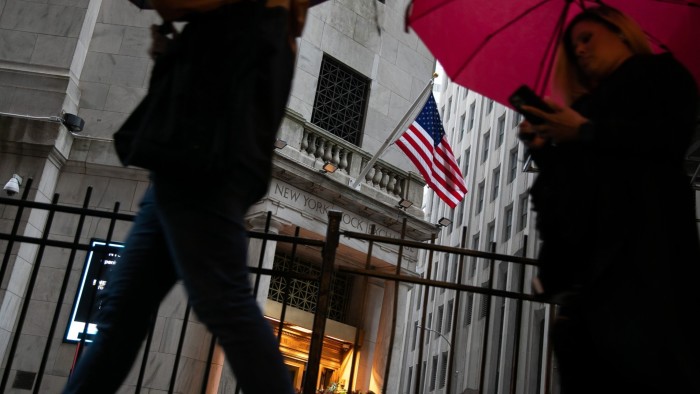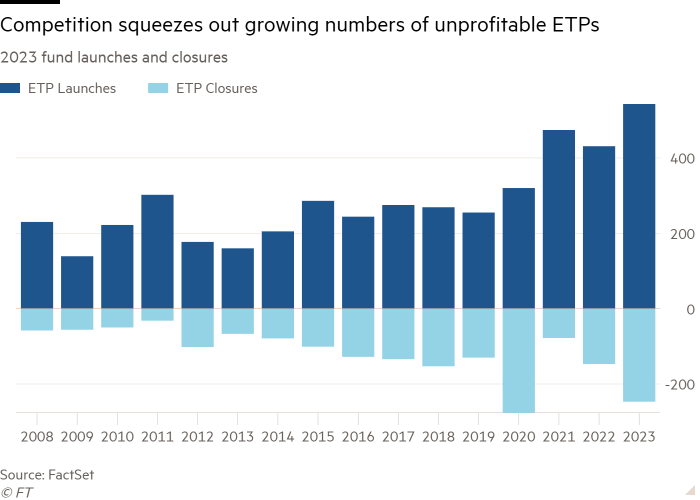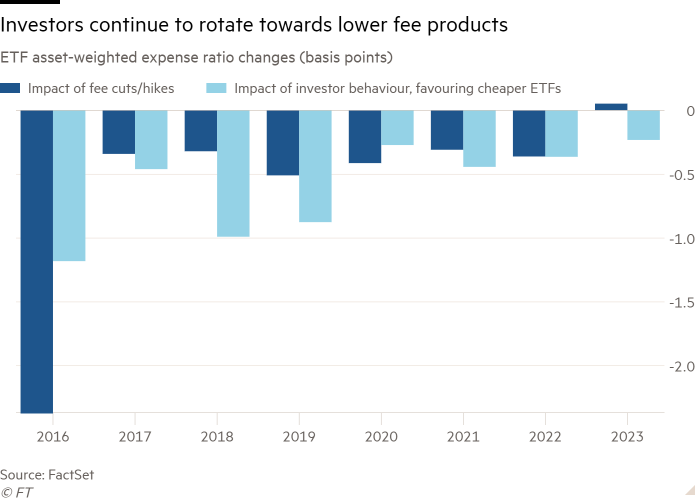Fee pressure intensifies in the US ETF market

Simply sign up to the Exchange traded funds myFT Digest -- delivered directly to your inbox.
Latest news on ETFs
Visit our ETF Hub to find out more and to explore our in-depth data and comparison tools
Inflows to US exchange traded funds hit $583bn in 2023, but 60 per cent of that money went into ETFs that cost investors no more than 0.1 per cent per year further squeezing margins for hard-pressed issuers, according to analysis by FactSet.
Asset-weighted expense ratios for equity and bond ETFs were shaved by between 0.003 per cent and 0.002 per cent compared to the previous year, indicating how little room issuers feel they have left for manoeuvre.
Plain vanilla equity funds were the hardest hit with fees dropping from an average of 0.12 per cent to 0.113 per cent.
The most popular funds, those tracking the S&P 500, the total US stock market and the Bloomberg Aggregate Bond index, cost an average of just 0.03 per cent per year.
The intense fee competition has led some ETF issuers to just give up — while there were a record 543 launches of exchange traded products in 2023, there were a near-record 247 closures, the FactSet research shows.

Nonetheless, some ETF issuers, perhaps responding to the tightening margins across their product range, raised fees on certain products. In 2023, 87 ETF providers raised fees on 463 US-listed ETFs vs 64 who imposed cuts.
Among the largest ETF issuers, defined as those with $50bn or more in assets under management, First Trust imposed the largest average fee hike of 0.016 per cent, while Fidelity and Dimensional made the largest cuts of 0.015 per cent and 0.012 per cent respectively.
ETF investors responded by holding back on investing in funds that raised their fees and increasing flows to funds that cut investor costs.

Elisabeth Kashner, director of global fund analytics at FactSet and author of the report, focuses on the fortunes of the largest ETFs whose fees increased during 2023: the iShares Russell 1000 Growth ETF (IWF) and the iShares Russell 1000 Value ETF (IWD).
The funds’ fee calculation rules meant that published expense ratios on the iShares ETFs rose by a minuscule amount from 0.1846 per cent on January 1 2023 to 0.1879 per cent on August 1. However, Vanguard’s equivalent ETFs — the Vanguard Russell 1000 Growth ETF (VONG) and the Vanguard Russell 1000 Value Index ETF (VONV) — grabbed an additional 4.2 percentage points of the four funds’ combined market share.
“Fee hikes — or the appearance of such — in 2023 were risky moves,” Kashner writes, noting in the report that the latest gains in market share for Vanguard’s funds, which currently carry expense ratios of 0.08 per cent, add to gains that started to be made in when it began cutting fees in December 2014.
Despite the encroachment, however, Vanguard’s share of the four funds’ total assets has only recently crept above the 15 per cent mark.
“These holders could be highly trading-cost-avoidant (the iShares spreads are currently just 0.01 per cent vs 0.02 per cent for Vanguard), trapped by unrealised capital gains or brokerage platform restrictions, or simply prone to inertia,” Kashner suggested.
Trading volumes on the four funds would suggest that Kashner might be right on the trading cost hypothesis and that the iShares funds are attracting shorter-term holders. Bloomberg’s three-month average daily trading volume data shows that IWD trades almost 10 times more than VONV, while IWF trades six times more than VONG.
“IWF and IWD’s trading volumes enable the funds to be used as financial instruments or asset allocation tools for investors to efficiently access and express their views at scale on these market segments,” said Rachel Aguirre, head of US iShares product at BlackRock.
“iShares has more than 1,400 ETFs to serve the broadest set of clients — asset owners, asset managers, wealth and individual investors,” she added.
The fierce competition, however, suggests that BlackRock, like all asset managers, will have to continue to focus on investor costs.
Latest news on ETFs

Visit the ETF Hub to find out more and to explore our in-depth data and comparison tools helping you to understand everything from performance to ESG ratings
“The ETF market remains fiercely competitive, even as ETFs become increasingly popular with retail investors,” said Shelly Antoniewicz, deputy chief economist at the Investment Company Institute.
“According to preliminary data from a forthcoming industry report on fund fees from the Investment Company Institute, overall ETF expense ratios continued to tick down in 2023, for both index and active ETFs,” she added.
She noted that more than $200bn in flows went to US-focused index equity ETFs with expenses ratios in the lowest quartile in 2023.
Kashner said the numbers were grim reading for ETF issuers, especially anyone planning to enter the fray for the first time.
“Asset managers should think twice before getting into this business,” she said. “They face the challenge of developing a winning strategy in a very competitive market.”
Comments